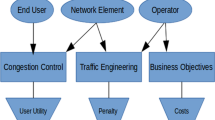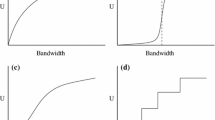Abstract
This paper reports new results concerning the capabilities of a family of service disciplines aimed at providing per-connection end-to-end delay (and throughput) guarantees in high-speed networks. This family consists of the class of rate-controlled service disciplines, in which traffic from a connection is reshaped to conform to specific traffic characteristics, at every hop on its path. When used together with a scheduling policy at each node, this reshaping enables the network to provide end-to-end delay guarantees to individual connections. The main advantages of this family of service disciplines are their implementation simplicity and flexibility. On the other hand, because the delay guarantees provided are based on summing worst case delays at each node, it has also been argued that the resulting bounds are very conservative which may more than offset the benefits. In particular, other service disciplines such as those based on Fair Queueing or Generalized Processor Sharing (GPS), have been shown to provide much tighter delay bounds. As a result, these disciplines, although more complex from an implementation point-of-view, have been considered for the purpose of providing end-to-end guarantees in high-speed networks. In this paper, we show that through “proper” selection of the reshaping to which we subject the traffic of a connection, the penalty incurred by computing end-to-end delay bounds based on worst cases at each node can be alleviated. Specifically, we show how rate-controlled service disciplines can be designed to outperform the Rate Proportional Processor Sharing (RPPS) service discipline. Based on these findings, we believe that rate-controlled service disciplines provide a very powerful and practical solution to the problem of providing end-to-end guarantees in high-speed networks.
Similar content being viewed by others
Explore related subjects
Discover the latest articles, news and stories from top researchers in related subjects.References
ATM UNI, Version 3.1 (1994).
C.-S. Chang, Stability, queue length and delay of deterministic and stochastic queueing networks, IEEE Trans. Automat. Contr. 39(1994)913–931.
D. Clark, S. Shenker and L. Zhang, Supporting real-time applications in an integrated packet network: Architecture and mechanisms,Proc. ACM SIGCOMM'92, Baltimore, MD (1992).
R. Cruz, A calculus for network delay, part I: Network analysis, IEEE Trans. Infrom. Theory 37(1991)114–131.
R.L. Cruz, Service burstiness and dynamic burstiness measures: A framework, J. High Speed Networks 1(1992)105–127.
A. Demers, S. Keshav and S. Shenker, Analysis and simulation of a fair queueing algorithm, J. Internetworking: Res Experience 1(1990)3–26.
L. Georgiadis, R. Guérin and A. Parekh, Optimal multiplexing on a single link: Delay and buffer requirements. Research Report RC 19711 (97393), IBM, T. J. Watson Research Center (1994). Short version appeared inProc. INFOCOM'94.
L. Georgiadis, R. Guérin, V. Peris and K. Sivarajan, Efficient network QoS provisioning based on per node traffic shaping, IBM Research Report, No. RC 20064 (1995).
D.D. Kandlur, K.G. Shin and D. Ferrari, Real-time communication in multi-hop networks,Proc. IEEE INFOCOM'91 (1991) pp. 300–307.
A.K. Parekh and R.G. Gallager, A generalized processor sharing approach to flow control in integrated services networks: The single-node case, IEEE/ACM Trans. Networking 1(1993)344–357.
A.K. Parekh and R.G. Gallager, A generalized processor sharing approach to flow control in integrated services networks: The multiple node case, IEEE/ACM Trans. Networking 2(1994)137–150.
A.K.J. Parekh, A generalized processor sharing approach to flow control in integrated services networks, Ph.D. Thesis, Laboratory for Information and Decision Systems, Massachusetts Institute of Technology, Cambridge, MA 02139, USA (1992). No. LIDS-TH-2089.
C. Partridge, A proposed flow specification, RFC 1336 (1992).
H. Zhang and D. Ferrari, Rate-controlled service disciplines, J. High Speed Networks 3(1994)389–412.
Q. Zheng and K. Shin, On the ability of establishing real-time channels in poin-to-point packet-switching networks, IEEE Trans. Commun. 42(1994):1096–1105.
Author information
Authors and Affiliations
Rights and permissions
About this article
Cite this article
Georgiadis, L., Guérin, R., Peris, V. et al. The effect of traffic shaping in efficiently providing end-to-end performance guarantees. Telecommunication Systems 5, 71–83 (1996). https://doi.org/10.1007/BF02109727
Issue Date:
DOI: https://doi.org/10.1007/BF02109727




